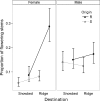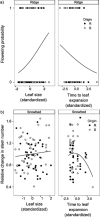The Response of the Alpine Dwarf Shrub Salix herbacea to Altered Snowmelt Timing: Lessons from a Multi-Site Transplant Experiment
- PMID: 25893438
- PMCID: PMC4403918
- DOI: 10.1371/journal.pone.0122395
The Response of the Alpine Dwarf Shrub Salix herbacea to Altered Snowmelt Timing: Lessons from a Multi-Site Transplant Experiment
Abstract
Climate change is altering spring snowmelt patterns in alpine and arctic ecosystems, and these changes may alter plant phenology, growth and reproduction. To predict how alpine plants respond to shifts in snowmelt timing, we need to understand trait plasticity, its effects on growth and reproduction, and the degree to which plants experience a home-site advantage. We tested how the common, long-lived dwarf shrub Salix herbacea responded to changing spring snowmelt time by reciprocally transplanting turfs of S. herbacea between early-exposure ridge and late-exposure snowbed microhabitats. After the transplant, we monitored phenological, morphological and fitness traits, as well as leaf damage, during two growing seasons. Salix herbacea leafed out earlier, but had a longer development time and produced smaller leaves on ridges relative to snowbeds. Longer phenological development times and smaller leaves were associated with reduced sexual reproduction on ridges. On snowbeds, larger leaves and intermediate development times were associated with increased clonal reproduction. Clonal and sexual reproduction showed no response to altered snowmelt time. We found no home-site advantage in terms of sexual and clonal reproduction. Leaf damage probability depended on snowmelt and thus exposure period, but had no short-term effect on fitness traits. We conclude that the studied populations of S. herbacea can respond to shifts in snowmelt by plastic changes in phenology and leaf size, while maintaining levels of clonal and sexual reproduction. The lack of a home-site advantage suggests that S. herbacea may not be adapted to different microhabitats. The studied populations are thus unlikely to react to climate change by rapid adaptation, but their responses will also not be constrained by small-scale local adaptation. In the short term, snowbed plants may persist due to high stem densities. However, in the long term, reduction in leaf size and flowering, a longer phenological development time and increased exposure to damage may decrease overall performance of S. herbacea under earlier snowmelt.
Conflict of interest statement
Figures



Similar articles
-
Evolutionary potential in the Alpine: trait heritabilities and performance variation of the dwarf willow Salix herbacea from different elevations and microhabitats.Ecol Evol. 2016 May 12;6(12):3940-52. doi: 10.1002/ece3.2171. eCollection 2016 Jun. Ecol Evol. 2016. PMID: 27516856 Free PMC article.
-
Small-scale drivers: the importance of nutrient availability and snowmelt timing on performance of the alpine shrub Salix herbacea.Oecologia. 2016 Apr;180(4):1015-24. doi: 10.1007/s00442-015-3394-3. Epub 2015 Aug 4. Oecologia. 2016. PMID: 26235963
-
Small-scale patterns in snowmelt timing affect gene flow and the distribution of genetic diversity in the alpine dwarf shrub Salix herbacea.Heredity (Edinb). 2014 Sep;113(3):233-9. doi: 10.1038/hdy.2014.19. Epub 2014 Mar 12. Heredity (Edinb). 2014. PMID: 24619183 Free PMC article.
-
Predicted responses of arctic and alpine ecosystems to altered seasonality under climate change.Glob Chang Biol. 2014 Oct;20(10):3256-69. doi: 10.1111/gcb.12568. Epub 2014 Jun 2. Glob Chang Biol. 2014. PMID: 24599697 Review.
-
How Climate Change May Impact Plant Reproduction and Fitness by Altering the Temporal Separation of Male and Female Flowering.Glob Chang Biol. 2024 Oct;30(10):e17533. doi: 10.1111/gcb.17533. Glob Chang Biol. 2024. PMID: 39400973 Review.
Cited by
-
Does the Genomic Landscape of Species Divergence in Phaseolus Beans Coerce Parallel Signatures of Adaptation and Domestication?Front Plant Sci. 2018 Dec 19;9:1816. doi: 10.3389/fpls.2018.01816. eCollection 2018. Front Plant Sci. 2018. PMID: 30619396 Free PMC article.
-
Simultaneous selection on vegetative and reproductive phenology in a perennial herb.Ecol Evol. 2022 Feb 15;12(2):e8610. doi: 10.1002/ece3.8610. eCollection 2022 Feb. Ecol Evol. 2022. PMID: 35222970 Free PMC article.
-
Snowmelt timing, phenology, and growing season length in conifer forests of Crater Lake National Park, USA.Int J Biometeorol. 2018 Feb;62(2):273-285. doi: 10.1007/s00484-017-1449-3. Epub 2017 Sep 30. Int J Biometeorol. 2018. PMID: 28965255
-
On the Causes of Rapid Diversification in the Páramos: Isolation by Ecology and Genomic Divergence in Espeletia.Front Plant Sci. 2018 Dec 3;9:1700. doi: 10.3389/fpls.2018.01700. eCollection 2018. Front Plant Sci. 2018. PMID: 30581444 Free PMC article.
-
Analysis of the genetic diversity and population structure of Salix psammophila based on phenotypic traits and simple sequence repeat markers.PeerJ. 2019 Feb 18;7:e6419. doi: 10.7717/peerj.6419. eCollection 2019. PeerJ. 2019. PMID: 30805247 Free PMC article.
References
-
- Rixen C, Dawes MA, Wipf S, Hagedorn F (2012) Evidence of enhanced freezing damage in treeline plants during six years of CO2 enrichment and soil warming. Oikos 121: 1532–1543.
-
- Steger C, Kotlarski S, Jonas T, Schär C (2012) Alpine snow cover in a changing climate: a regional climate model perspective. Clim Dyn 41: 735–754.
-
- Beniston M, Keller F, Koffi B, Goyette S (2003) Estimates of snow accumulation and volume in the Swiss Alps under changing climatic conditions. Theor Appl Climatol 76: 125–140.
-
- Wipf S, Stoeckli V, Bebi P (2009) Winter climate change in alpine tundra: plant responses to changes in snow depth and snowmelt timing. Clim Change 94: 105–121.
Publication types
MeSH terms
Associated data
LinkOut - more resources
Full Text Sources
Other Literature Sources

